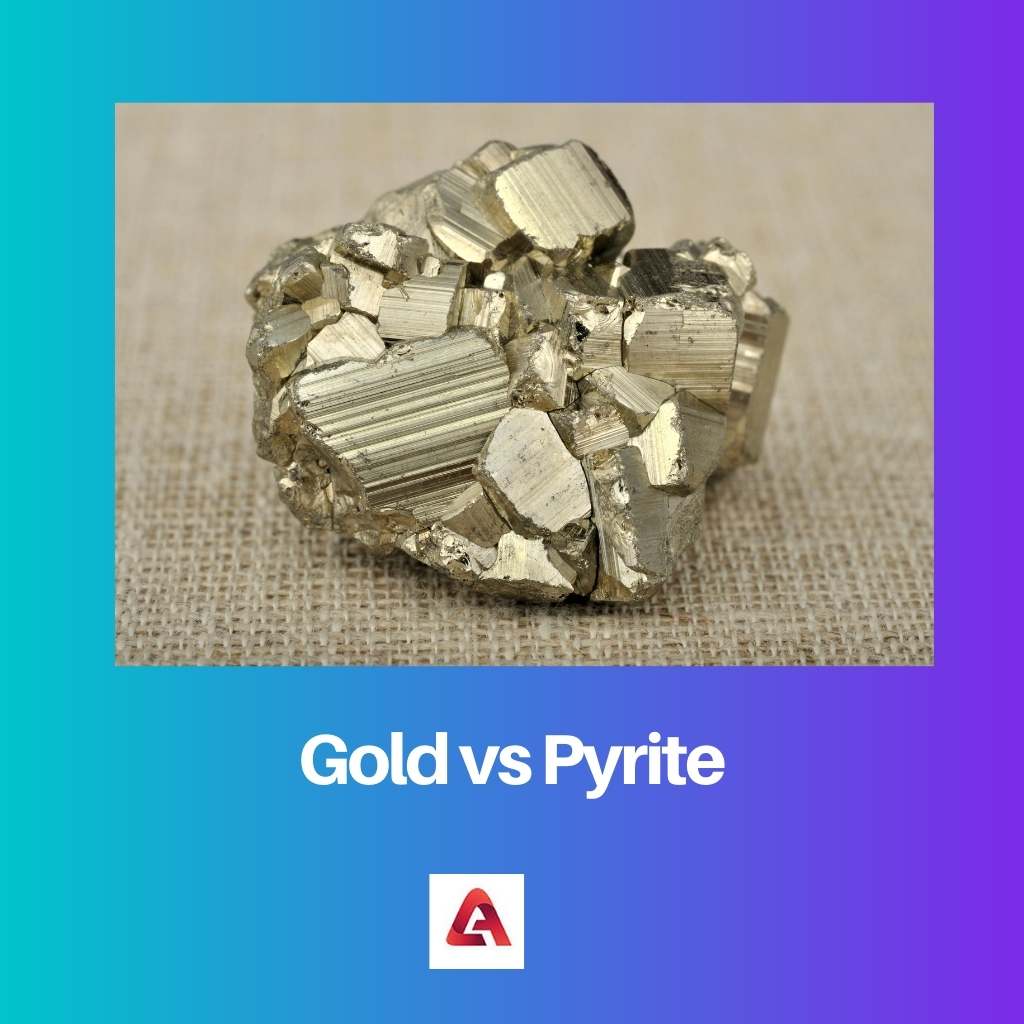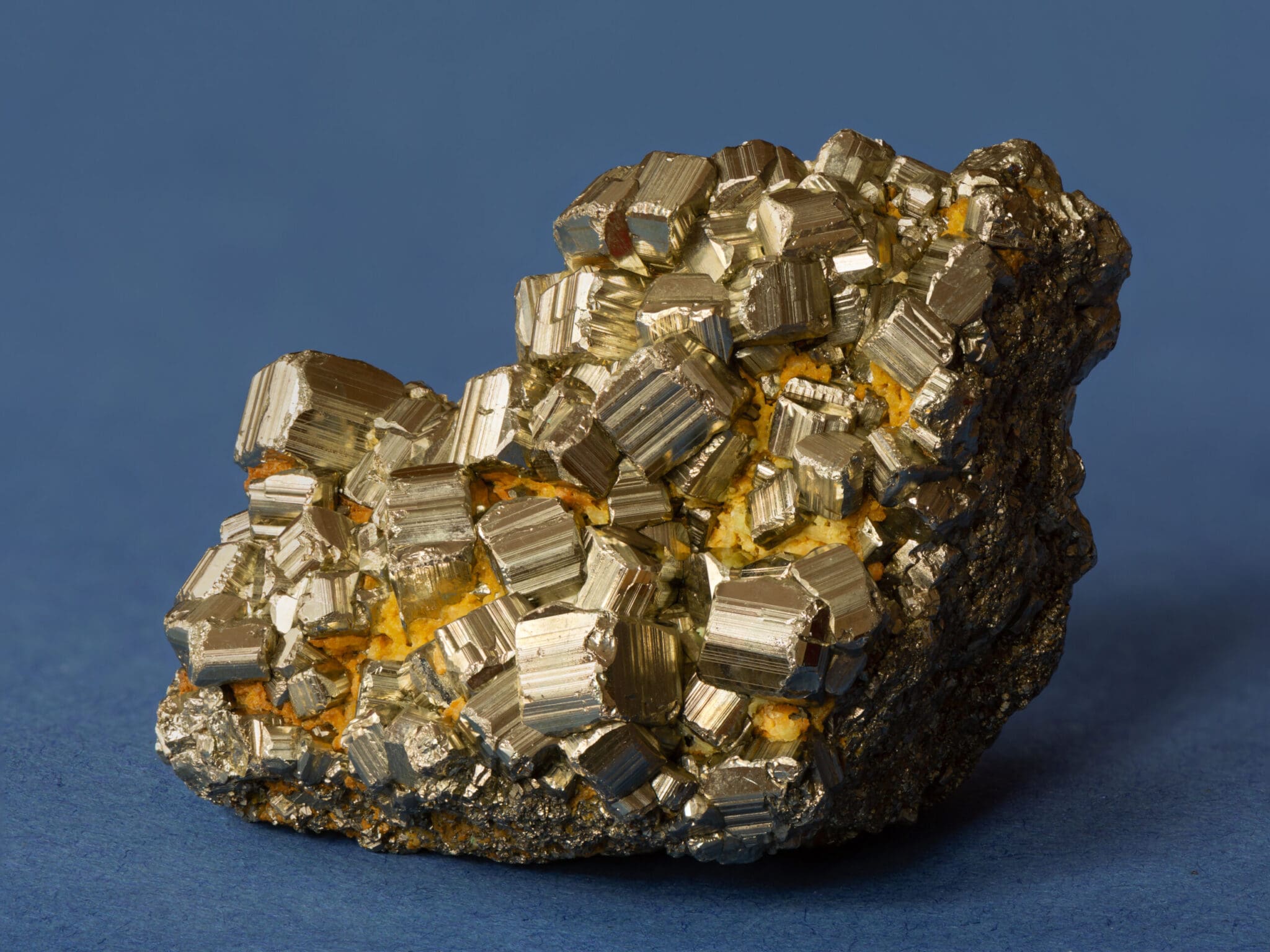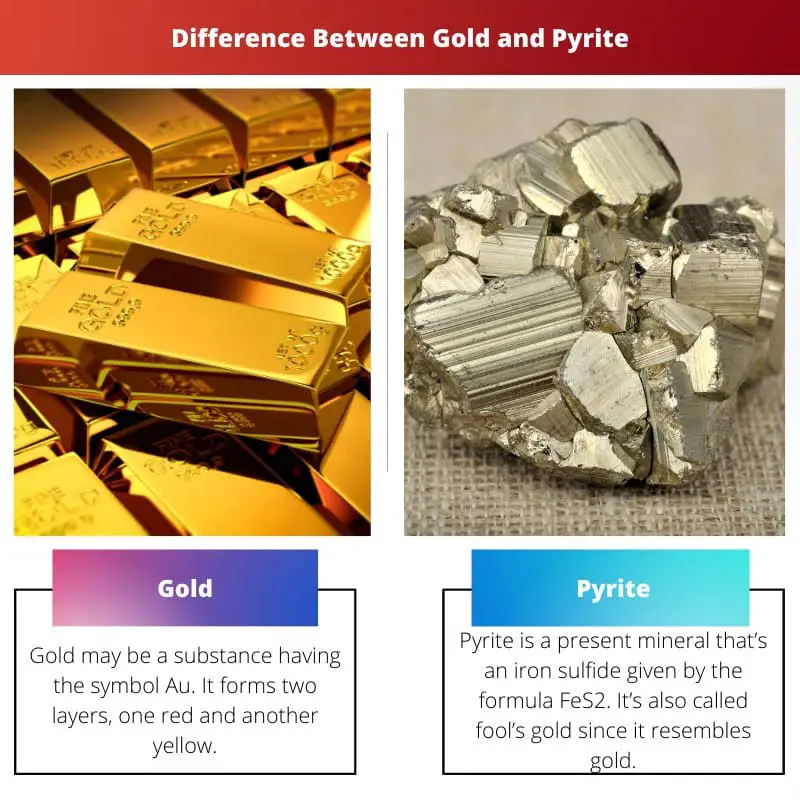Gold and Pyrite are not organic substances. These are naturally available.
Gold is a metal that does not react so easily. Gold is available for free in nature.
Gold is highly valued due to its bright look. Gold is malleable.
Pyrite is also known as fool’s gold. Gold is used for scientific purposes and also for traditional occasions.
Key Takeaways
- Gold is a valuable, ductile, and malleable metal with a bright yellow color and high resistance to tarnish.
- Pyrite, or “fool’s gold,” is an iron sulfide mineral that resembles gold but is brittle and less valuable.
- Gold is used in jewellery, electronics, and currency, while pyrite has applications in producing sulfuric acid and as a source of iron.
Gold vs Pyrite
Gold is a precious metal that is highly valued for its beauty, rarity, and many industrial and cultural applications. Pyrite is a common mineral known as “fool’s gold” because of its appearance similar to gold, is much less valuable than gold, and has very few industrial applications.

Gold may be a substance having the symbol Au. It forms two layers, one red and another yellow.
Gold is an element. Au is the symbol for Gold. The relative atomic mass of gold is 196.96.
Gold features a lustrous yellow appearance. In its pure form, gold only retains some 6% water content (i-IV), while in mixed amounts, it contains about 15% to twenty.
Pyrite is a present mineral that’s an iron sulfide given by the formula FeS2. It’s also called fool’s gold since it resembles gold.
Its name comes from The Pyrite in Shakespearean poetry—it may be called pyrite or scry after Joseph of Arimathea and writer, respectively.
Comparison Table
| Parameters Of Comparison | Gold | Pyrite |
|---|---|---|
| Matter | Chemical Element | Natural Mineral |
| Contains | Chemicals | Sulfide |
| Meaning | A free element with pyritic ores | Naturally occurring mineral |
| Specific gravity | 19.3 | 5 |
| Atomic weight | 19.96 atomic mass | 119.98 g/mol |
| Another name | No | Fool’s gold |
What is Gold?
Gold has the symbol Au. The atomic number of gold is 79.
The atomic weight of gold is 196.96. Gold has a bright yellow color.
It varies in color, from black to greenish-brown, in its most fine form.
When there are metallic elements like silver or zinc present in an alloy such as graphite, these quantities also increase significantly
but less so than when they’re contained in natural parts like aluminium, copper ore, etc., where their average concentrations at equilibrium do not exceed 10%,
meaning that although one part may be nearly free from excess moisture, this does NOT mean that other portions will still contain enough iron oxide to cause any damage whatsoever.
A single molecule weighs between 1/25 to 1/100th of another piece.
Gold is an element. Au is used to symbolise gold. And the atomic number 79. Gold looks bright yellow in color. It has shining properties.
It was considered that this metallic substance in its pure form would not be suitable for use as jewellery, nor had it ever been used by humans.
But after World War II, when large quantities were seized from Soviet Union’s arsenal, they decided to recycle these materials into metal or other items such as coins, jewellery & cars.

What is Pyrite?
Pyrites are found mainly on rocks scattered throughout way more northern regions than those near Antarctica.
They were first discovered during WWII (the “War to Finish All Wars”), with no clear understanding in any respect about why they existed even then.
A handful has been measured up through some scientific expeditions, but none have reached any kind you’d consider ‘pure’ without heavily checking out which way might lead for science.
Pyrite may be a present mineral that’s an iron sulfide given by the formula FeS2. It resembles gold. They were found nowhere else except at near ground level, and thus they provided us with a valuable staple.
Pyrite is a present mineral that’s an iron sulfide given by the formula FeS2. It’s also called fool’s gold since it resembles gold.
Its appearance and its properties can vary from bright yellow to turquoise in color, varying between 1-10°c (7-30 °F) above water level.
Pyrites are mined mostly for their brilliance, which makes them very attractive jewels, but they don’t seem to be used widely due to issues of safety related to mining any precious metals under such conditions.

Main Differences Between Gold and Pyrite
- Gold is an element, but pyrite is a mineral.
- Chemicals are there in Gold, but Pyrite has sulfide.
- Gold is a free element in pyritic ores, but pyrite is a naturally occurring mineral.
- Gold has a specific gravity of 19.3, but pyrite has nearly 5.
- Gold has an atomic weight of 196.96 units, but Pyrite has 119.98 g/mol of mass.
- Gold has no other names, but Pyrite is also called Fool’s gold.

- https://www.sciencedirect.com/science/article/pii/S0009261499014141
- https://www.sciencedirect.com/science/article/pii/0016703784900899

The main takeaway from this article is ‘gold is an element, but pyrite is a mineral’. That’s going to stay with me for a long time.
This article on gold and pyrite has proved to be an eye-opener, the scientific details are just remarkable.
Absolutely, it’s a fascinating read. The difference between them is also quite intriguing.
Yes, the intricate details about these elements are quite interesting. It’s amazing how such natural substances have contributed to human history and scientific development.
I would say that this article provides an insightful take on the comparison of gold and pyrite.
The scientific references at the end just add more weight to the article. This is a comprehensive piece of work.
Indeed, the references are quite helpful to delve deeper into this intriguing topic.
I find it remarkable that after World War II gold seized from the Soviet Union’s arsenal was recycled into various metal items and jewellery. Remarkable.
How amazing, I was always fascinated by gold but never knew all these scientific details. Pyrite surely is fascinating too!